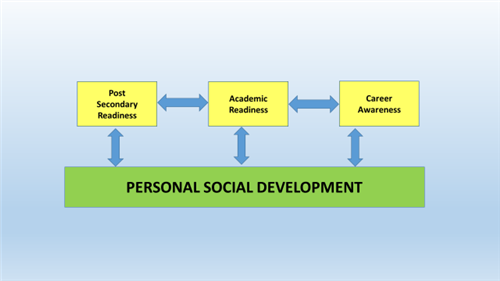-
Counseling Counts brings together a diverse array of cross-sector stakeholders with a
comprehensive goal for students shared by both the school district and the community. This goal is to:Provide Personal and Social Development
By providing personal & social development three sub goals are addressed:
Provide Academic Advising
Ensure College Readiness (including all post-secondary options)
Ensure Career Readiness
Without personal and social development the other three goals are more difficult to successfully attain.
This is reflected in the chart below.

By applying the principles and practices of community collaboration, the Counseling Counts engages stakeholders from the public, private, and social sectors to coordinate and align a school counseling system. The power of this collective approach comes about when the four goals are conceived and pursued as a coherent whole. This differs from today’s “counselor-centric” model. The counselor, in effect, becomes the coordinator and facilitator of a robust “system of support” and not an isolated advisor.Said another way: It’s a SYSTEMS thing, not a single thing
-
These goals are supported by eight guiding principles that govern the design, operations,
and development of the Counseling Counts Model. These guiding principles are:Community-Centered: The act of "counseling" goes beyond the essential relationship between a counselor and student. It is the responsibility of the entire community: everyone's a counselor. Systems-Focused: Student outcomes are the result of the interactions among people, programs, and organizations, and not the result of any one thing. It’s a systems thing, not a single thing. Relationship-Rich: Transforming a system is ultimately about improving relationships among the people who shape the system. Rewiring stakeholder relationships and redesigning the ways people work together to serve students is the work, not the creation of more programs or interventions. Asset-Based: An asset-based approach assumes that there are untapped resources and capacities inherent in every individual, organization, or community which can be put into use to improve the current conditions. True-Partnership: All stakeholders are responsible for and accountable to each other and the success of the whole counseling system. Process-Oriented: The system evolves using a common language and approach for engaging cross-sector stakeholders in the collective work. Co-Created Goals: The stakeholders set goals collectively and accept the mutual responsibility for achieving them. Shared-Metrics: A shared understanding of the counseling system develops by looking at the same data, at the same time, using the same process.



